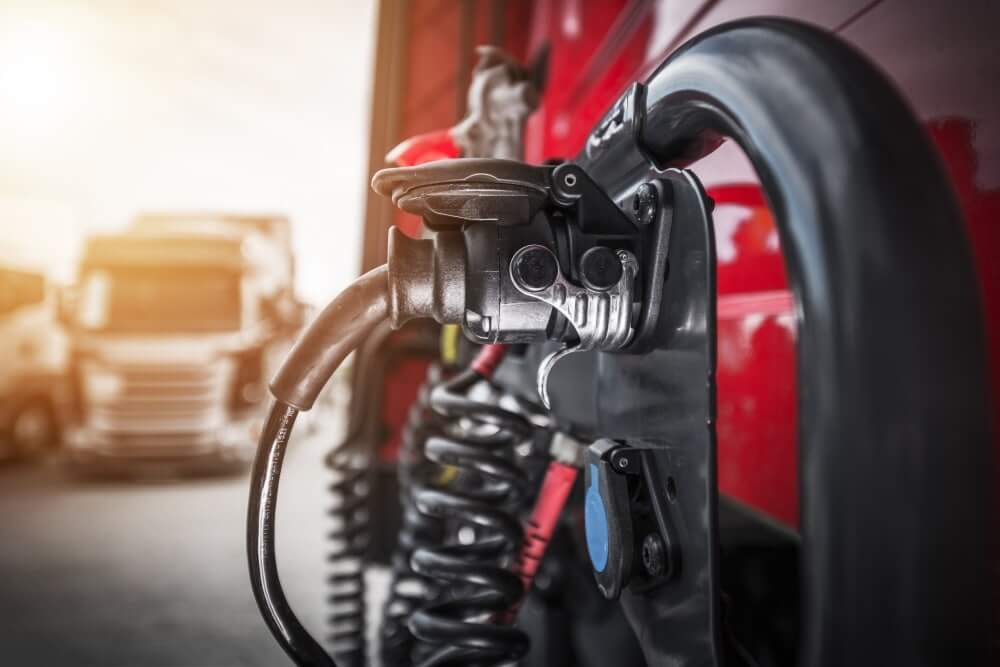With more shippers demanding zero-emission transport and new incentives making electric vehicles (EVs) increasingly attractive, Canadian fleet operators are accelerating their shift toward electrification.
But one question continues to loom large: How do EV maintenance costs really compare to traditional internal combustion engine (ICE) vehicles?
In short: EVs are cheaper to maintain — and the savings can be significant. While the upfront cost (CapEx) of electric trucks can be higher, the total cost of ownership (TCO) often tilts in favour of EVs thanks to lower maintenance, fewer breakdowns, and reduced fuel costs over time. Here we explore where those savings come from — and why a well-maintained charging infrastructure plays a key role in keeping EVs reliable, efficient, and operational.
EV Maintenance Costs: Backed by the Latest Data
EVs don’t just cut fuel costs — they consistently outperform ICE vehicles when it comes to service, maintenance, and repair (SMR) expenses.
A 2023 report from Consumer Reports found that EV and plug-in hybrid owners pay about half as much for maintenance and repairs compared to ICE vehicle owners. And that trend holds true for commercial vehicles, too.
According to the International Council on Clean Transportation (ICCT), battery-electric trucks now have the lowest per-mile maintenance costs of any powertrain :
- Battery-electric: $0.176/mile
- Diesel: $0.246/mile
- Natural gas: $0.298/mile
These numbers add up fast, especially across large fleets — often delivering savings of thousands of dollars per vehicle, per year.
What Makes EVs Cheaper to Maintain?
EVs are mechanically simpler. Fewer moving parts means fewer things that can break. Here’s where the biggest savings come from:
Simpler Powertrains
EVs can have as few as 20 moving parts, compared to 2,000+ in ICE vehicles. This means:
- No oil changes
- No spark plugs or timing belts
- No exhaust systems to maintain
Fewer parts result in fewer breakdowns and lower costs.
Regenerative Braking
Regenerative braking systems recover energy during deceleration and reduce wear on brake pads. For example, Volvo’s VNR Electric can recover up to 15% of braking energy, extending both range and component lifespan.
Brake components in EVs typically last two to three times longer than in ICE vehicles.
EV Batteries: Long Life, Low Touch
While batteries are the most expensive EV component, they require very little routine maintenance.
- Most OEMs offer 8- to 10-year warranties
- Real-world data from Geotab shows EV batteries degrade at just 1.8% per year
- Many batteries now last 15+ years, outliving the vehicle in many fleet applications
Even better: The price of lithium-ion batteries has dropped by over 80% since 2010, with further decreases expected through 2030.
The Role of Charging Infrastructure in EV Maintenance
A well-maintained EV is only as reliable as the charging ecosystem that supports it. Charging infrastructure isn’t just about access — it plays a crucial role in preserving battery health, managing vehicle uptime, and preventing costly repairs.
Proper Charging Reduces Battery Degradation
Consistent charging habits — supported by well-calibrated Level 2 or managed DC fast chargers — help avoid battery stress and overheating. Poorly maintained or outdated chargers can lead to:
- Inconsistent voltage delivery
- Overheating that degrades battery chemistry
- Longer dwell times that impact route planning and downtime
Routine maintenance of charging stations ensures safe, consistent power delivery and extends battery lifespan.
Charger Diagnostics Enable Preventative Maintenance
Many commercial charging stations now include smart diagnostics and remote monitoring. These systems:
- Detect abnormalities (like voltage fluctuations or overheating)
- Alert operators to upcoming maintenance needs
- Reduce the risk of sudden charger failure that could leave vehicles offline
Fleet Integration and Uptime
For return-to-base fleets, chargers must be available, operational, and suited to the duty cycle. Proper scheduling, load management, and redundancy planning are essential for:
- Avoiding queueing delays
- Ensuring overnight full charges
- Maintaining fleet deployment rates without interruption
In short, a reliable charging strategy is not just a fueling solution — it’s a key part of your maintenance infrastructure.
What Still Needs Maintenance on an EV?
Despite their lower overall maintenance burden, EVs are not maintenance-free. For fleets looking to scale with confidence, understanding what does require attention is essential for minimizing downtime and protecting assets.
Tires
EVs typically weigh more than their ICE counterparts, leading to:
- Faster tread wear, particularly on front axles
- Uneven wear if regenerative braking is heavily biased toward specific wheels
Recommendation: Implement more frequent tire rotation intervals and consider EV-specific tires that are engineered for load and efficiency.
Brake Fluid & Hydraulic Systems
While regenerative braking reduces wear on brake pads and rotors, hydraulic systems still need inspection:
- Brake fluid can degrade with heat and moisture over time
- Calipers and ABS modules require routine checks
Recommendation: Follow OEM maintenance intervals and use diagnostic tools to flag early signs of moisture contamination or system wear.
Thermal Management Systems
Modern EVs use liquid cooling loops to maintain optimal battery temperature. These systems include:
- Radiators
- Coolant pumps
- Heater cores
- Thermal valves and sensors
Recommendation: Inspect coolant levels, check for leaks, and monitor pump performance using your EV telematics suite.
HVAC and Cabin Filters
EVs rely more heavily on electric heating and cooling systems.
Recommendation: Ensure proper filter maintenance for air quality and inspect the electric compressor system in high-usage vehicles.
Chassis & Suspension
These parts are shared with ICE vehicles and subject to the same wear patterns.
Recommendation: Schedule quarterly suspension checks, especially for fleets operating in winter or on uneven roads.
Real-World Savings for Medium- and Heavy-Duty Fleets
The cost benefits of EV maintenance are playing out in real-world operations across North America.
Maintenance Costs by Vehicle Class
According to the U.S. Department of Energy :
| Bus Type | Maintenance Cost per Mile |
| Battery-Electric Bus | $0.26 |
| Hybrid Diesel Bus | $0.32 |
| Diesel Bus | $0.46 |
That’s a 43% drop in maintenance costs for battery-electric buses compared to diesel.
Class 6–8 Commercial Vehicles
According to a detailed analysis by Element Fleet, electric medium- and heavy-duty trucks—including Classes 6 to 8—are projected to achieve total cost of ownership (TCO) parity with diesel by 2027, driven largely by energy savings and reduced maintenance costs.
What this means for fleets: Even before full-scale fuel savings kick in, reduced maintenance and operational efficiencies are already improving margins—and parity is just around the corner.
Special Use Cases
Municipalities and public utilities running medium-duty EVs have reported:
- Fewer service calls
- Lower parts inventory needs
- Reduced technician hours per vehicle
Fleets running telematics-integrated EVs can predict service needs before they result in downtime — something few ICE systems can match.
Preparing Your Fleet to Maximize EV Maintenance Savings
Understanding EV systems is one thing. Operationalizing those savings at scale is another. To unlock the full value of EV maintenance reductions, fleet operators should prioritize three areas: people, process, and partnerships.
Upskill Your Workforce
EVs come with unique diagnostic systems, digital controls, and thermal management requirements. Investing in targeted training ensures:
- Fewer repair errors
- More efficient troubleshooting
- Improved driver behavior
Canada now offers coordinated national support to help fleets and maintenance providers develop EV-specific expertise. In 2023, Natural Resources Canada (NRCan) launched a national EV technician training platform, developed in partnership with industry associations and technical colleges. These programs are designed to build workforce capacity across diagnostics, safety protocols, and high-voltage component servicing.
Adapt Your Maintenance Schedules
EVs require less frequent service but different types of inspections. Adjust your fleet’s maintenance strategy to:
- Shift focus from engine diagnostics to electrical system health
- Emphasize predictive rather than reactive servicing
- Schedule fewer but more targeted checkups
Tip: Use OEM telematics or third-party platforms to monitor battery state-of-health, thermal efficiency, and regenerative braking usage.
Work with a Specialized Electrification Partner
EVs bring new complexity in warranties, telematics, charger maintenance, and OEM servicing schedules. Leasing with an EV-focused partner like 7Gen means:
- 24/7 support and remote diagnostics
- Embedded SMR tracking in every lease
- Preventative maintenance included in select regions
What’s unique: 7Gen’s leasing bundles in British Columbia include all maintenance costs — meaning no surprise repair bills or delays due to technician shortages.
Final Takeaways
- EVs are consistently cheaper to maintain than diesel trucks, even in heavy-duty use cases
- Regenerative braking, simplified powertrains, and battery warranties are the biggest cost savers
- Training and support are essential to unlocking the full value of fleet electrification
- While CapEx for EVs may be higher, TCO advantages are increasingly clear across all commercial segments
- A robust, well-maintained charging infrastructure is critical to ensuring vehicle uptime, protecting battery health, and enabling seamless operations
Curious How Much You Could Save?
Let us help you model the cost savings for your own fleet — including maintenance, fuel, and incentives.
Talk to our team!
Note: The information provided in this article is based on the latest available data as of June 2025. For personalized advice and the most current developments, please consult with industry experts or reach out to our team.

